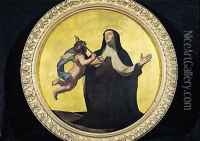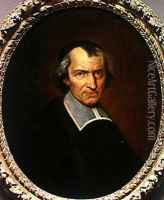Jean Baptiste de Champaigne Paintings
Jean Baptiste de Champaigne was a French painter, born in Brussels in 1631. He was part of the famous Champaigne family of artists and the nephew of Philippe de Champaigne, a significant figure in the French Baroque painting movement. Philippe played a crucial role in Jean Baptiste's life, not only as his uncle but also as his teacher and mentor. Under Philippe's guidance, Jean Baptiste honed his skills and developed his artistic talents.
Jean Baptiste de Champaigne's career was closely linked with the French court, and he often worked on commissions for religious institutions and members of the aristocracy. His style, like his uncle's, was characterized by a blend of Flemish realism and French classicism, with a strong emphasis on clarity of composition, restrained color palettes, and meticulous attention to detail. Despite the influence of his uncle, Jean Baptiste managed to carve out his own artistic identity and enjoyed a successful career in his own right.
Over the years, Jean Baptiste de Champaigne produced a variety of works, including religious paintings, portraits, and still lifes. His paintings were known for their elegance and often contained moral or allegorical messages, which was a common feature in Baroque art. He was also recognized for his skill in depicting textures and materials, which brought a tangible realism to his work.
Jean Baptiste de Champaigne's contributions to the art world continued until his death in 1681. His works can be found in various museums and collections, where they continue to be studied and admired for their beauty and historical significance. Through his paintings, Jean Baptiste de Champaigne left a lasting legacy that reflects the artistic trends and cultural values of 17th-century France.



